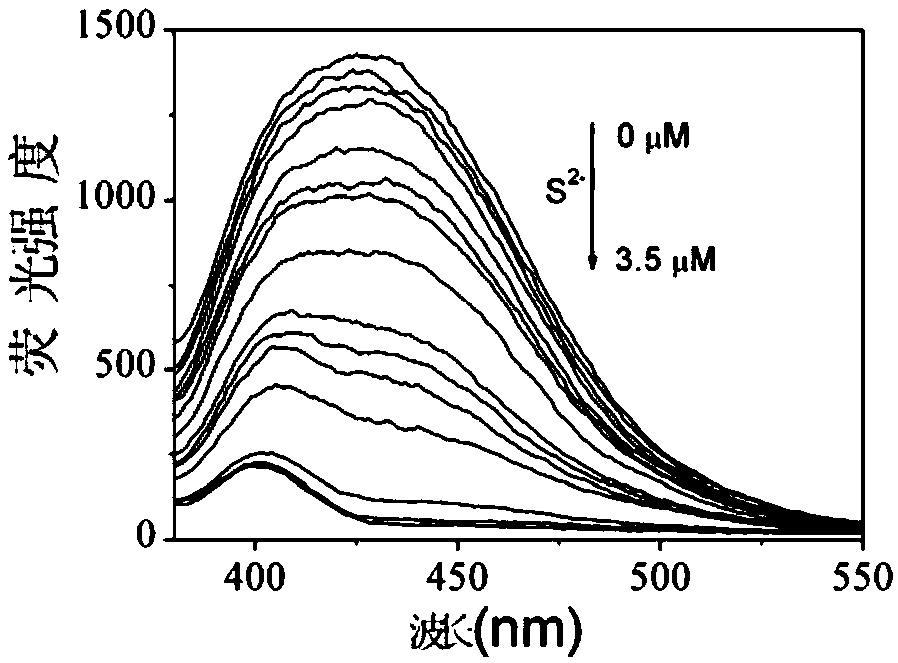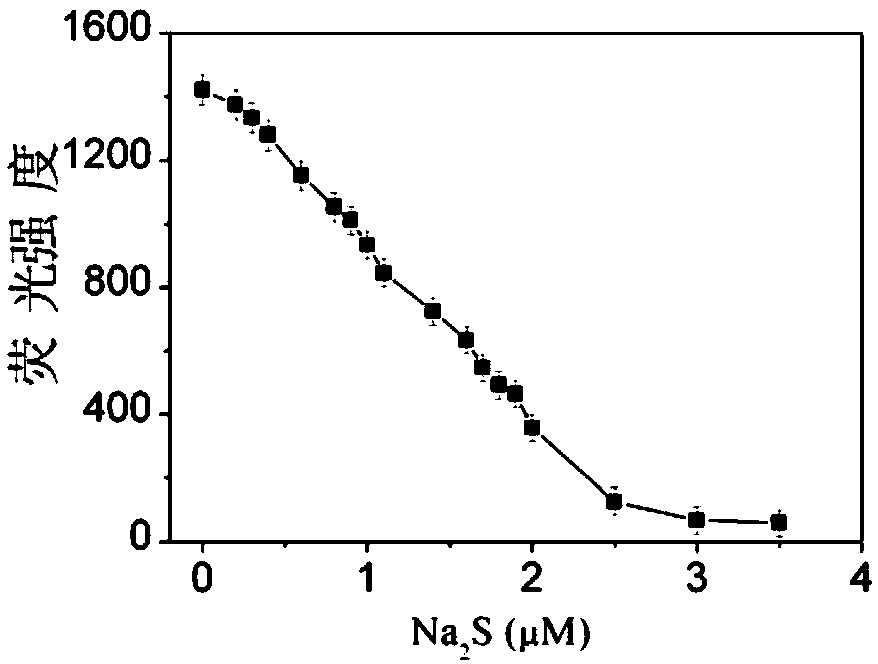Sulfide ion detection method based on Ce(III)/AgNCs composite nano cluster material
A technology of nano-clusters and sulfide ions, which is applied in the field of detection of sulfide ions, can solve the problems of low luminous efficiency and low sensitivity, and achieve the effects of high sensitivity, simple operation, good selectivity and anti-interference ability
- Summary
- Abstract
- Description
- Claims
- Application Information
AI Technical Summary
Problems solved by technology
Method used
Image
Examples
Embodiment 1
[0037] A method for detecting sulfur ions based on Ce(III) / AgNCs composite nano-cluster material, comprising the following steps:
[0038] A. Mix 50 μL of AgNCs nanocluster solution with a concentration of 420 μM and 1 mL of 50 μM cerium nitrate solution in a series of test tubes, and react for 5 minutes to form a Ce(III) / AgNCs composite nanocluster material solution;
[0039] B. Add different concentrations of Na to the mixture in each tube 2 S solution, by HNO 3 or NaOH to adjust the pH of the mixed solution to 7.0, and dilute to 5mL with deionized water, and stir for 10 minutes; 2 The final concentrations of S solution were 0, 0.2 μM, 0.3 μM, 0.4 μM, 0.6 μM, 0.8 μM, 0.9 μM, 1.0 μM, 1.1 μM, 1.4 μM, 1.6 μM, 1.7 μM, 1.8 μM, 1.9 μM, 2.0 μM , 2.5 μM, 3.0 μM, 3.5 μM.
[0040] C, measure the fluorescence intensity of above-mentioned each group solution, gained fluorescence spectrogram is as follows figure 1 shown; from figure 1It can be seen that the fluorescence intensity of...
Embodiment 2
[0049] Effect of Ce(III) on Fluorescence Intensity of AgNCs
[0050] At room temperature, mix a certain volume of AgNCs solution with different final concentrations of Ce(III) ions in a series of test tubes, add deionized water to make the volume reach 5.0 mL, and the final concentration of AgNCs is 4.2 μM , the final concentration of Ce(III) ions is 0~15μM; 3 or NaOH to adjust the mixture to pH 7. The excitation wavelength was set at 358nm, the excitation and emission slits were 10.0nm and 10.0nm respectively, and the fluorescence spectra were measured respectively.
[0051] Such as Figure 9 As shown, with the increase of Ce(III) ion concentration, the fluorescence intensity of AgNCs gradually increased. The effect of Ce(III) ion concentration on the fluorescence intensity of AgNCs is as follows: Figure 10 shown. from Figure 9 , 10 It can be seen that the fluorescence intensity of AgNCs reaches the strongest when the Ce(III) ion concentration reaches 9 μM. This is ...
Embodiment 3
[0053] Ce(III) / AgNCs composite nanocluster materials on S 2- Selective experiments for detection
[0054] A stable and excellent fluorescent probe must have good selectivity and anti-interference ability. In order to explore the anti-interference ability of this kind of fluorescent composite nano-cluster material, the present invention has selected some common ions (F - , Cl - 、 Br - , NO 2 - , NO 3 - , CrO 4 2- , CO 3 2- 、SCN - 、K + 、Na + ) to do interference experiments, the final concentration of interference ions is 10.0μM, S 2- The final concentration of ions was 1.0 μM. The results show that adding sulfur ions can maximize the degree of fluorescence quenching of the system, and except for sulfur ions, other ions have little effect on the degree of fluorescence quenching of the Ce(III) / AgNCs composite system, almost negligible. The experimental results show that the Ce(III) / AgNCs composite system has good selectivity and anti-interference in the detection ...
PUM
| Property | Measurement | Unit |
|---|---|---|
| particle size | aaaaa | aaaaa |
Abstract
Description
Claims
Application Information
 Login to View More
Login to View More - R&D
- Intellectual Property
- Life Sciences
- Materials
- Tech Scout
- Unparalleled Data Quality
- Higher Quality Content
- 60% Fewer Hallucinations
Browse by: Latest US Patents, China's latest patents, Technical Efficacy Thesaurus, Application Domain, Technology Topic, Popular Technical Reports.
© 2025 PatSnap. All rights reserved.Legal|Privacy policy|Modern Slavery Act Transparency Statement|Sitemap|About US| Contact US: help@patsnap.com



